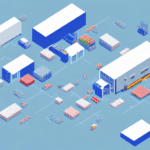6 River Systems vs. Knapp: An In-Depth Comparison
In today's rapidly evolving landscape, the shift towards automated and digitized processes underscores the necessity of reliable and advanced warehouse fulfillment systems. Two prominent players currently making waves in the market are 6 River Systems and Knapp. This article delves into a comprehensive comparison of these systems, examining their features, costs, customer reviews, implementation processes, and more, to aid you in making an informed decision for your business.
Overview of 6 River Systems and Knapp
What is 6 River Systems?
6 River Systems offers a collaborative warehouse fulfillment solution that integrates advanced robotics, software, and cloud-based technology to streamline and optimize warehouse operations. Designed to eliminate inefficiencies, it boosts productivity in e-commerce and retail environments. In 2019, Shopify acquired 6 River Systems, expanding its global presence to over 20 countries. This acquisition has enhanced Shopify's logistics capabilities, providing merchants with robust fulfillment solutions.
What is Knapp?
Knapp is a global leader in automated warehouse solutions, providing a diverse range of products and services to enhance warehouse logistics, including software and material handling equipment. With over 70 years of industry experience, Knapp maintains a robust footprint across Europe, Asia, and North America. The company continues to advance warehouse automation, committed to delivering top-tier logistics solutions.
Key Differences Between 6 River Systems and Knapp
- Approach to Automation: 6 River Systems emphasizes collaborative robots that work alongside human employees, fostering a synergistic environment. Knapp, however, offers a broader spectrum of automated systems with minimal human interaction, catering to varying operational needs.
- Software Integration: 6 River Systems provides a cloud-based software system that seamlessly integrates with e-commerce platforms like Shopify, enhancing flexibility. Knapp offers a more standalone software system, which may require additional integration efforts with platforms such as Magento and SAP ERP.
- Target Market: 6 River Systems is tailored for small to medium-sized businesses, offering cost-effective solutions. Knapp targets larger corporations with high-volume orders, reflecting in its pricing structure, which represents a more significant investment.
- Employee Training and Support: 6 River Systems prioritizes employee training, providing on-site training for collaborative robots and 24/7 customer support. Knapp focuses more on technological advancements, with comparatively less emphasis on training and support.
Features and Capabilities
6 River Systems
6 River Systems boasts collaborative robots, known as Chuck, that enhance efficiency by working alongside human pickers. Its robust software system offers real-time insights into warehouse operations, order prioritization, and more. Additionally, 6 River Systems introduced a machine learning algorithm in 2023 that predicts order demand and adjusts picking routes accordingly, significantly improving fulfillment accuracy and speed.
Knapp
Knapp provides a variety of automation solutions, including shuttle systems and automated storage and retrieval systems (AS/RS). The company is exploring augmented reality technology to improve order picking accuracy and speed, positioning itself at the forefront of warehouse innovation. Knapp’s BLUE YOND platform integrates intelligent technologies to optimize material flow and operational efficiency.
- User-Friendly Interface: 6 River Systems allows warehouse managers to customize workflows effortlessly.
- Comprehensive Training: Knapp ensures warehouse staff are well-equipped to operate and maintain their systems through extensive training programs.
Pros and Cons
6 River Systems
Pros:
- Ease of use with intuitive collaborative robots requiring minimal training.
- Flexibility allows customization to fit various warehouse layouts and workflows, enhancing efficiency and productivity.
- Seamless integration with major e-commerce platforms.
Cons:
- May lack standalone automation solutions, limiting scalability for larger operations.
- Dependence on human-robot collaboration might not suit all operational models.
Knapp
Pros:
- Wide range of automation solutions ideal for complex processes and high-volume orders.
- Advanced technology can provide businesses with a competitive edge.
- Highly scalable solutions suitable for large enterprises.
Cons:
- Higher initial costs can be a barrier for smaller enterprises.
- Implementation may require significant time and resources.
Cost Comparison and ROI
The implementation cost of warehouse fulfillment systems varies based on warehouse size and specific business requirements. Generally, 6 River Systems is more cost-effective for small to medium-sized businesses, as its collaborative approach requires less initial investment in equipment and hardware. Conversely, Knapp's automated systems, while initially more expensive, may offer long-term savings by reducing manual labor and increasing operational efficiency, particularly for larger warehouses with high order volumes.
Customization levels also impact costs. Knapp provides higher customization, suited for businesses with unique needs, whereas 6 River Systems offers standardized solutions ideal for simpler operations.
According to a Forbes report, businesses can expect a return on investment within 2-3 years when implementing advanced warehouse automation solutions.
Implementation and Integration
Implementing both 6 River Systems and Knapp is relatively straightforward, though the complexity varies. 6 River Systems' cloud-based software simplifies setup and integration with platforms like Shopify, allowing for quicker deployment. Knapp's software also integrates with various e-commerce platforms but may require more time and resources for the physical installation of its automated systems.
Both companies excel in customer support during implementation, offering training and guidance to ensure seamless setup and ongoing operations. 6 River Systems provides comprehensive training programs to help staff effectively utilize collaborative robots, while Knapp offers extensive technical support to manage their advanced automation solutions.
Customer Feedback and Reviews
Feedback for both 6 River Systems and Knapp is predominantly positive. Users of 6 River Systems report notable increases in productivity and efficiency, praising the intuitive design and seamless integration with e-commerce platforms. For instance, an e-commerce retailer highlighted a 45% increase in order processing speed after adopting 6 River Systems.
Knapp's automated systems are praised for their reliability and effectiveness. A major retail chain noted a 50% reduction in order errors following the implementation of Knapp’s AS/RS solutions. However, some users note the higher initial costs associated with Knapp's solutions as a potential drawback.
Overall, 6 River Systems is lauded for its flexibility and customization, benefiting businesses with unique warehouse layouts. Knapp is recognized for its scalability and capability to handle large order volumes, making it a preferred choice for sizable enterprises.
Choosing the Right System for Your Business
The optimal choice between 6 River Systems and Knapp hinges on your business's specific requirements. If you operate a smaller warehouse or favor a collaborative fulfillment approach, 6 River Systems may be more suitable. Conversely, if your warehouse is large with high-volume orders necessitating advanced automation, Knapp might be the better fit.
Consider the cost structure relative to your budget and the potential long-term benefits of each system. Additionally, evaluate the level of support and training required—6 River Systems offers robust customer service and training programs, whereas Knapp may demand a higher degree of technical expertise.
- Assess Business Requirements: Determine the specific needs of your warehouse operations.
- Evaluate Warehouse Size: Larger warehouses with higher order volumes may benefit more from Knapp's solutions.
- Budget Considerations: Align the cost of implementation with your financial capacity.
- Review Features and Integrations: Compare the features and compatibility with your existing systems.
- Analyze Customer Reviews: Learn from the experiences of other businesses in similar industries.
Case Studies: Success Stories with 6 River Systems and Knapp
Numerous businesses have reaped significant benefits from implementing 6 River Systems or Knapp's automated solutions. For instance, a major e-commerce company reported a 48% improvement in productivity after adopting 6 River Systems, while a renowned retail giant achieved a 98% reduction in order errors using Knapp's solutions. Additionally, a logistics company experienced increased throughput following the implementation of Knapp's shuttle system, underscoring the transformative impact of these technologies.
Integrations with Other E-commerce Platforms
Both 6 River Systems and Knapp facilitate seamless integrations with various e-commerce platforms to enhance warehouse fulfillment processes. 6 River Systems integrates effortlessly with platforms like Shopify, providing flexibility for online retailers. Knapp supports integrations with platforms such as SAP ERP and Magento, catering to diverse business needs.
Future Developments for 6 River Systems and Knapp
Both companies are committed to continuous innovation in warehouse fulfillment. 6 River Systems is developing new algorithms to further enhance the efficiency of their collaborative robots, including advancements in artificial intelligence to predict and adapt to fluctuating order demands. Meanwhile, Knapp is incorporating more artificial intelligence into their automated systems, aiming to increase efficiency and adaptability in complex warehouse environments. These developments are expected to drive the next generation of warehouse automation, offering even greater scalability and performance.
Conclusion: Making the Right Choice for Your Warehouse
Selecting the appropriate warehouse fulfillment system is crucial for optimizing your operations and scaling your business. While 6 River Systems and Knapp offer robust solutions, they differ in their approaches, costs, and implementation strategies. Conduct a thorough analysis of your business needs, evaluate each system's features and costs, and consider customer feedback to determine which solution aligns best with your objectives. Whether you opt for the collaborative flexibility of 6 River Systems or the advanced automation of Knapp, investing in the right technology will drive your warehouse efficiency and business growth.




















